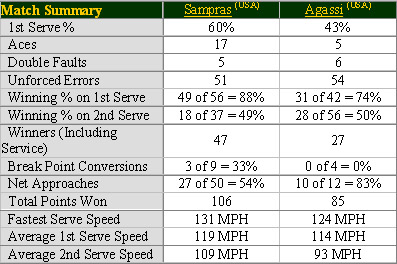Score: 6-3, 6-4, 7-5
Sampras had 16 aces and 5 doubles.
Agassi had 5 aces and 6 doubles.
(The ATP site has the same count).
I counted 27 times that Sampras got a service return error from Agassi (of those, I judged 10 as service winners).
Agassi got 31 service return errors from Sampras (of those, I judged 2 as service winners).
That is remarkable, that Agassi got more of these "free" kind of points on his serve than Sampras did, considering the superiority of Sampras' serve. It just illustrates the quality of Agassi's return.
If you include the aces, then Sampras won 43 "free" points, Agassi 36.
Per the ATP site:
Sampras won 3 of 9 break points, Agassi 0 of 4.
My count of the winners:
Sampras had 30 winners: 8 FH, 4 BH, 9 FHV, 4 BHV, and 5 overheads.
Agassi had 22 winners: 10 FH, 7 BH, 0 FHV, 3 BHV, and 2 overheads.
Sampras had 4 service return winners, three from the forehand. Two of the winners came off Agassi’s first serve.
None of the return winners were passes, and he had just one passing shot, from the backhand.
Agassi returned Sampras’ second serve with four winners – two off each side. All of these were passes.
Agassi had 7 additional passing shots (four from the backhand).
Stats from NBC:
Per NBC, as of the fourth game of the second set Sampras was serving at 63%, with 26 winners and 6 unforced errors. Agassi was serving at 45%, with 10 winners and 8 unforced errors.
NBC credited Sampras with 58 winners and 22 unforced errors for the whole match.
(If NBC counted 30 non-service winners as I did, then NBC must have credited him with 11 service winners, compared to the 10 that I gave him. Note that they gave him 17 aces, rather than the 16 in the ATP count and my own; they credited him with an ace on a serve that Agassi's racquet barely grazed).
As of the fifth game of the second set, NBC had Sampras winning 18 of 25 at net, Agassi 2 of 4. As of the 10th game of the third set, Sampras was at 41 of 62, Agassi at 9 of 13.
Sampras had 16 aces and 5 doubles.
Agassi had 5 aces and 6 doubles.
(The ATP site has the same count).
I counted 27 times that Sampras got a service return error from Agassi (of those, I judged 10 as service winners).
Agassi got 31 service return errors from Sampras (of those, I judged 2 as service winners).
That is remarkable, that Agassi got more of these "free" kind of points on his serve than Sampras did, considering the superiority of Sampras' serve. It just illustrates the quality of Agassi's return.
If you include the aces, then Sampras won 43 "free" points, Agassi 36.
Per the ATP site:
Sampras won 3 of 9 break points, Agassi 0 of 4.
My count of the winners:
Sampras had 30 winners: 8 FH, 4 BH, 9 FHV, 4 BHV, and 5 overheads.
Agassi had 22 winners: 10 FH, 7 BH, 0 FHV, 3 BHV, and 2 overheads.
Sampras had 4 service return winners, three from the forehand. Two of the winners came off Agassi’s first serve.
None of the return winners were passes, and he had just one passing shot, from the backhand.
Agassi returned Sampras’ second serve with four winners – two off each side. All of these were passes.
Agassi had 7 additional passing shots (four from the backhand).
Stats from NBC:
Per NBC, as of the fourth game of the second set Sampras was serving at 63%, with 26 winners and 6 unforced errors. Agassi was serving at 45%, with 10 winners and 8 unforced errors.
NBC credited Sampras with 58 winners and 22 unforced errors for the whole match.
(If NBC counted 30 non-service winners as I did, then NBC must have credited him with 11 service winners, compared to the 10 that I gave him. Note that they gave him 17 aces, rather than the 16 in the ATP count and my own; they credited him with an ace on a serve that Agassi's racquet barely grazed).
As of the fifth game of the second set, NBC had Sampras winning 18 of 25 at net, Agassi 2 of 4. As of the 10th game of the third set, Sampras was at 41 of 62, Agassi at 9 of 13.
Last edited:

